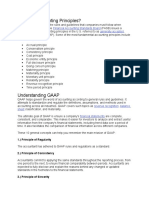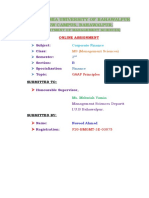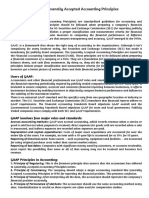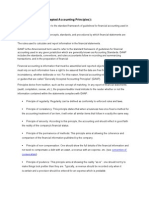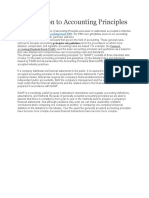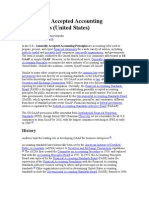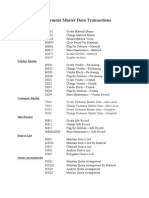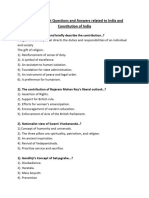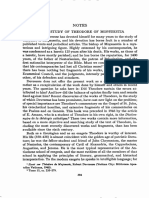What are Generally Accepted Accounting Principles?
Generally accepted accounting principles (GAAP) refer to a common set of accounting principles,
standards, and procedures issued by the Financial Accounting Standards Board (FASB). Public companies
in the United States must follow GAAP when their accountants compile their financial statements. GAAP
is a combination of authoritative standards (set by policy boards) and the commonly accepted ways of
recording and reporting accounting information. GAAP aims to improve the clarity, consistency, and
comparability of the communication of financial information.
GAAP may be contrasted with pro forma accounting, which is a non-GAAP financial reporting method.
Internationally, the equivalent to GAAP in the United States is referred to as international financial
reporting standards (IFRS). IFRS is followed in over 120 countries, including those in the European Union
(EU).
Generally Accepted Accounting Principles (GAAP) is a framework of accounting standards, rules and
procedures defined by the professional accounting industry, which has been adopted by nearly all
publicly traded U.S. companies.
GAAP
Understanding GAAP
GAAP helps govern the world of accounting according to general rules and guidelines. It attempts to
standardize and regulate the definitions, assumptions, and methods used in accounting across all
industries. GAAP covers such topics as revenue recognition, balance sheet classification, and materiality.
The ultimate goal of GAAP is ensure a company's financial statements are complete, consistent, and
comparable. This makes it easier for investors to analyze and extract useful information from the
company's financial statements, including trend data over a period of time. It also facilitates the
comparison of financial information across different companies.
These 10 general concepts can help you remember the main mission of GAAP:
1.) Principle of Regularity
The accountant has adhered to GAAP rules and regulations as a standard.
2.) Principle of Consistency
Accountants commit to applying the same standards throughout the reporting process to prevent errors
or discrepancies. Accountants are expected to fully disclose and explain the reasons behind any changed
or updated standards in the footnotes to the financial statements.
3.) Principle of Sincerity
The accountant strives to provide an accurate and impartial depiction of a company’s financial situation.
�4.) Principle of Permanence of Methods
The procedures used in financial reporting should be consistent.
5.) Principle of Non-Compensation
Both negatives and positives should be reported with full transparency and without the expectation of
debt compensation.
6.) Principle of Prudence
Emphasizing fact-based financial data representation that is not clouded by speculation.
7.) Principle of Continuity
While valuing assets, it should be assumed the business will continue to operate.
8.) Principle of Periodicity
Entries should be distributed across the appropriate periods of time. For example, revenue should be
reported in its relevant accounting period.
9.) Principle of Materiality / Good Faith
Accountants must strive for full disclosure in financial reports.
10.) Principle of Utmost Good Faith
Derived from the Latin phrase “uberrimae fidei” used within the insurance industry. It presupposes that
parties remain honest in all transactions.
characteristics of GAAP
There are four fundamental characteristics to GAAP:
1) Relevance
All information required for decision making must be present on the financial statements. Nothing
should be omitted or misstated if it would cause the interpretation of the statements to change. The
information must also be prepared in a timely manner.
2) Reliability
All information must be free of error and bias. Information must be objective and be verifiable.
3) Understandability
Readers of the financial statements must be able to understand the reports. Companies will usually
provide an extensive set of notes to accompany the financial statements.
4) Comparability
A company’s financial statements should be comparable from year to year. Financial statements will
usually have last year’s financial printed alongside this year’s financials.15



